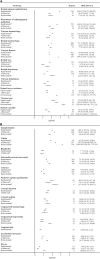Ocular adverse events associated with anti-VEGF therapy: A pharmacovigilance study of the FDA adverse event reporting system (FAERS)
- PMID: 36467087
- PMCID: PMC9716077
- DOI: 10.3389/fphar.2022.1017889
Ocular adverse events associated with anti-VEGF therapy: A pharmacovigilance study of the FDA adverse event reporting system (FAERS)
Abstract
Background: The purpose of this study is to identify and characterize ocular adverse events (AEs) that are significantly associated with anti-VEGF drugs for treatment of neovascular age-related macular degeneration and compare the differences between each drug, and provide clinical reference. Methods: Ocular AEs submitted to the US Food and Drug Administration were analyzed to map the safety profile of anti-VEGF drugs. The Pharmacovigilance tools used for the quantitative detection of signals were reporting odds ratio and bayesian confidence propagation neural network. Results: A total of 10,608,503 AE reports were retrieved from FAERS, with 20,836 for ranibizumab, 19,107 for aflibercept, and 2,442 for brolucizumab between the reporting period of Q1, 2004 and Q3, 2021. We found and analyzed the different AEs with the strongest signal in each drug-ranibizumab-macular ischaemia (ROR = 205.27, IC-2SD = 3.70), retinal pigment epithelial tear (ROR = 836.54, IC-2SD = 7.19); aflibercept-intraocular pressure increased (ROR = 31.09, IC-2SD = 4.61), endophthalmitis (ROR = 178.27, IC-2SD = 6.70); brolucizumab-retinal vasculitis (ROR = 2930.41, IC-2SD = 7.47) and/or retinal artery occlusion (ROR = 391.11, IC-2SD = 6.10), dry eye (ROR = 12.48, IC-2SD = 2.88). Conclusion: The presence of AEs should bring clinical attention. The use of anti-VEGF drugs should be based on the patient's underlying or present medical condition to reduce any adverse event associated with the treatment.
Keywords: adverse events; aflibercept; brolucizumab; pharmacovigilance; ranibizumab; safety signals.
Copyright © 2022 Ma, Pan, Liu, Qu, Xie, Xie, Cao and Chen.
Conflict of interest statement
The authors declare that the research was conducted in the absence of any commercial or financial relationships that could be construed as a potential conflict of interest.
Figures



Similar articles
-
Signal mining and analysis for central nervous system adverse events due to taking oxycodone based on FAERS database.Zhong Nan Da Xue Xue Bao Yi Xue Ban. 2023 Mar 28;48(3):422-434. doi: 10.11817/j.issn.1672-7347.2023.220304. Zhong Nan Da Xue Xue Bao Yi Xue Ban. 2023. PMID: 37164926 Free PMC article. Chinese, English.
-
Adverse events associated with brolucizumab: a disproportionality analysis of the FDA adverse event reporting system (FAERS).Expert Opin Drug Saf. 2024 Nov;23(11):1447-1452. doi: 10.1080/14740338.2024.2322712. Epub 2024 Feb 27. Expert Opin Drug Saf. 2024. PMID: 38404234
-
Safety profile of faricimab: a multi-source pharmacovigilance analysis using FAERS and JADER.BMC Pharmacol Toxicol. 2025 Apr 12;26(1):82. doi: 10.1186/s40360-025-00902-6. BMC Pharmacol Toxicol. 2025. PMID: 40221797 Free PMC article.
-
Analysis of Spontaneous Postmarket Case Reports Submitted to the FDA Regarding Thromboembolic Adverse Events and JAK Inhibitors.Drug Saf. 2018 Apr;41(4):357-361. doi: 10.1007/s40264-017-0622-2. Drug Saf. 2018. PMID: 29196988 Review.
-
Cardiovascular complications of modern multiple myeloma therapy: A pharmacovigilance study.Br J Clin Pharmacol. 2023 Feb;89(2):641-648. doi: 10.1111/bcp.15499. Epub 2022 Sep 9. Br J Clin Pharmacol. 2023. PMID: 35996166 Review.
Cited by
-
Retinal Artery Occlusion: A Review of Current Management Practices.J Ophthalmic Vis Res. 2024 Dec 31;19(4):488-507. doi: 10.18502/jovr.v19i4.16559. eCollection 2024 Dec. J Ophthalmic Vis Res. 2024. PMID: 39917461 Free PMC article. Review.
-
A Personal Scientific Journey in Ophthalmology: Twenty-Five Years of Translating Research into Novel Therapies.Pharmaceuticals (Basel). 2025 Jun 12;18(6):883. doi: 10.3390/ph18060883. Pharmaceuticals (Basel). 2025. PMID: 40573278 Free PMC article. Review.
-
Safety assessment of neurokinin-1 receptor antagonist: real-world adverse event analysis from the FAERS database.Front Pharmacol. 2024 Jul 31;15:1413709. doi: 10.3389/fphar.2024.1413709. eCollection 2024. Front Pharmacol. 2024. PMID: 39144621 Free PMC article.
-
25-hydroxyvitamin D3 inhibits oxidative stress and ferroptosis in retinal microvascular endothelial cells induced by high glucose through down-regulation of miR-93.BMC Ophthalmol. 2023 Jan 13;23(1):22. doi: 10.1186/s12886-022-02762-8. BMC Ophthalmol. 2023. PMID: 36639741 Free PMC article.
-
Adverse event reporting of faricimab: a disproportionality analysis of FDA adverse event reporting system (FAERS) database.Front Pharmacol. 2025 Mar 12;16:1521358. doi: 10.3389/fphar.2025.1521358. eCollection 2025. Front Pharmacol. 2025. PMID: 40144657 Free PMC article.
References
-
- Avery R. L., Castellarin A. A., Steinle N. C., Dhoot D. S., Pieramici D. J., See R., et al. (2014). Systemic pharmacokinetics following intravitreal injections of ranibizumab, bevacizumab or aflibercept in patients with neovascular AMD. Br. J. Ophthalmol. 98 (12), 1636–1641. 10.1136/bjophthalmol-2014-305252 - DOI - PMC - PubMed
LinkOut - more resources
Full Text Sources

